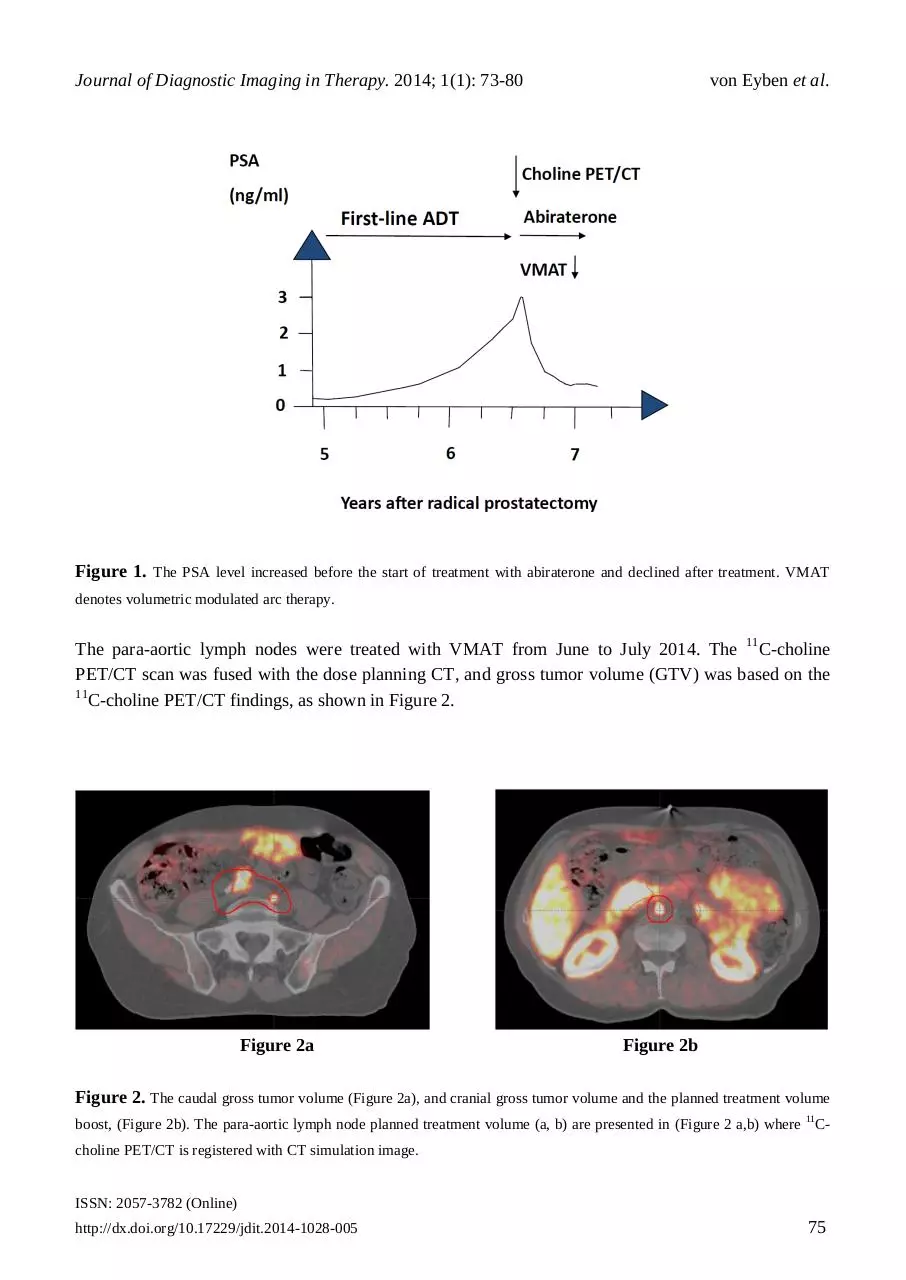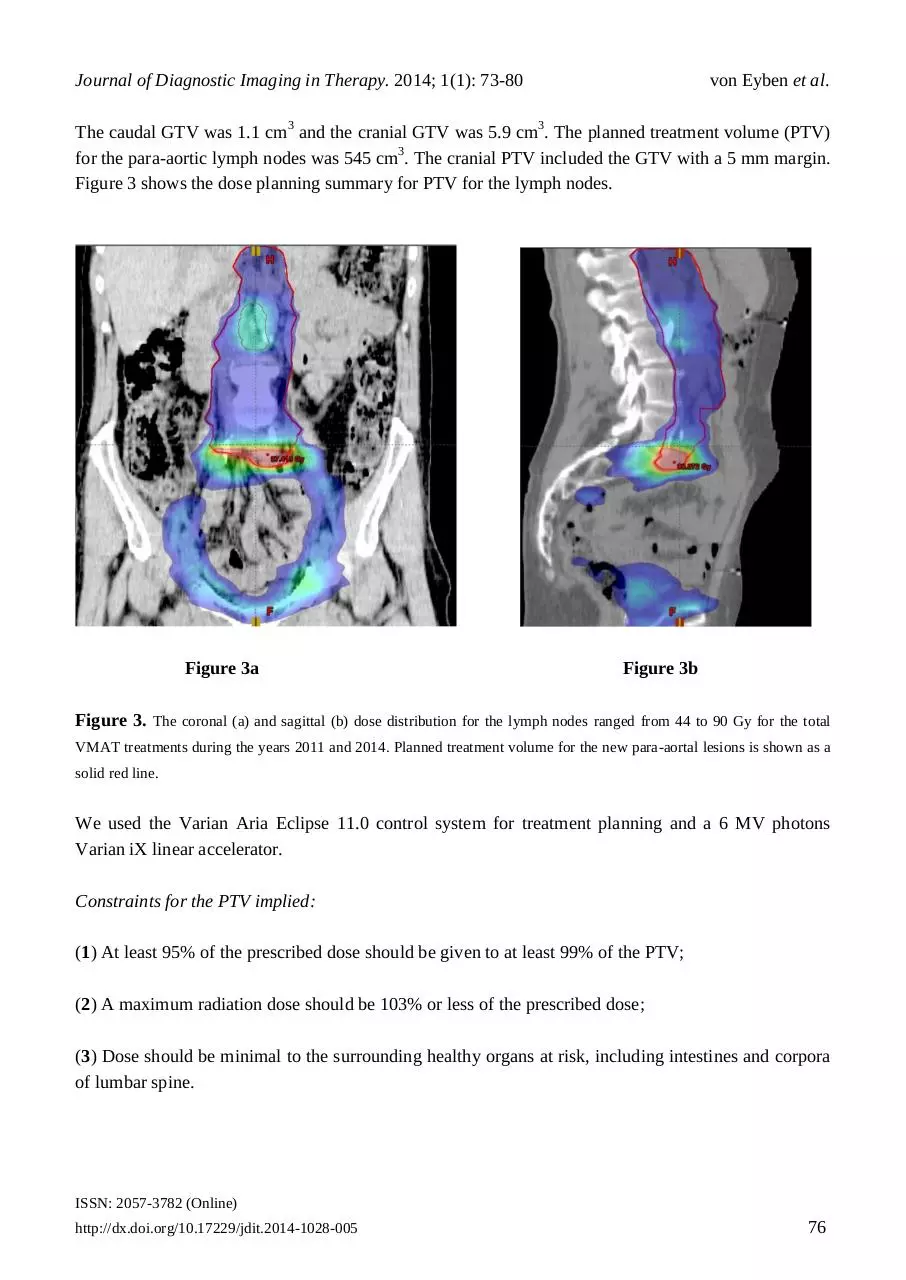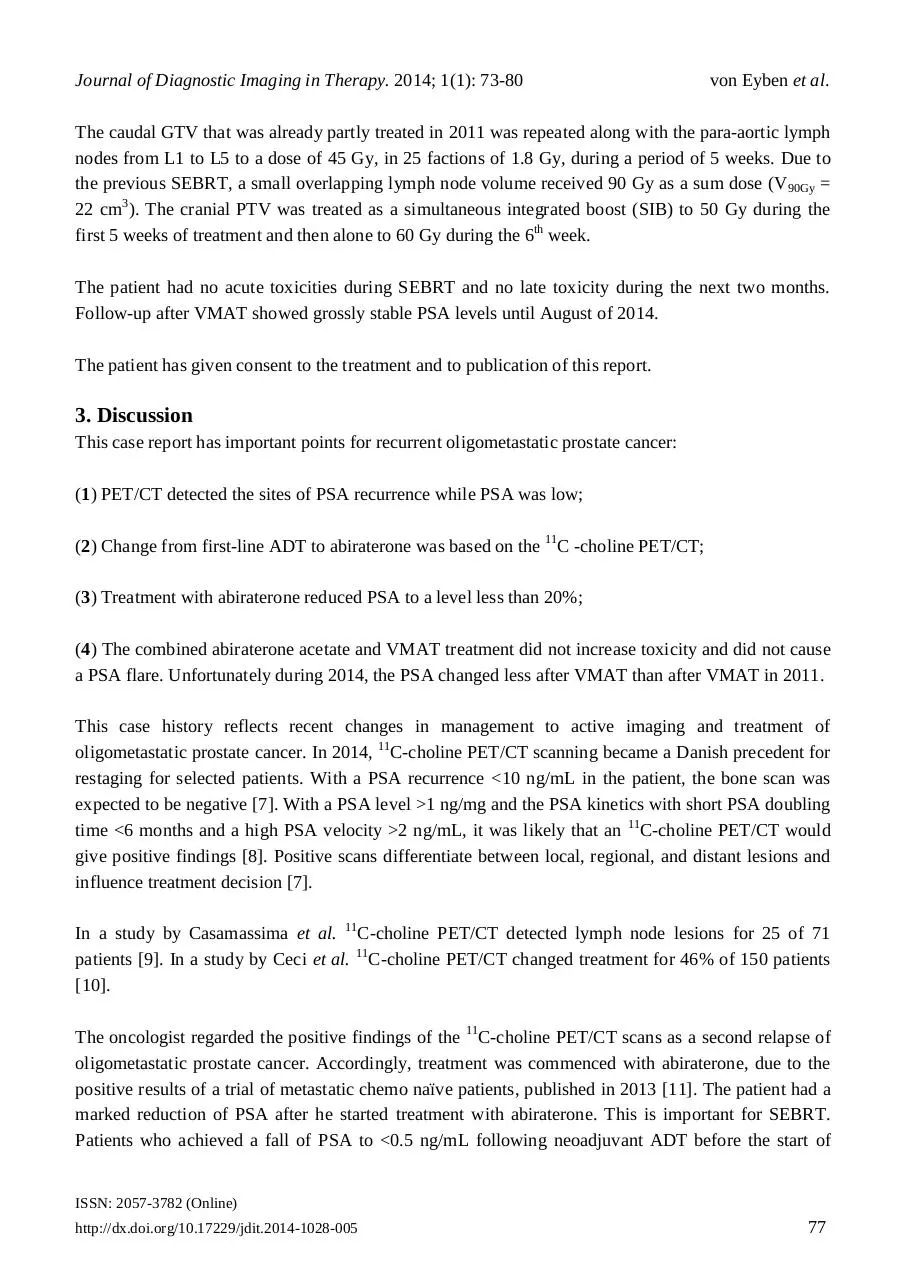JDIT 2014 1028 005 (PDF)
File information
Title:
Author: Sean
This PDF 1.3 document has been generated by Microsoft® Word 2010 / http://www.convertapi.com, and has been sent on pdf-archive.com on 30/05/2017 at 00:32, from IP address 90.218.x.x.
The current document download page has been viewed 296 times.
File size: 285.53 KB (8 pages).
Privacy: public file





File preview
Journal of Diagnostic Imaging in Therapy. 2014; 1(1): 73-80
von Eyben et al.
Open Medscience
Peer-Reviewed Open Access
JOURNAL OF DIAGNOSTIC IMAGING IN THERAPY
Journal homepage: www.openmedscience.com
Case Report R
Abiraterone and Volumetric Modulated Arc Therapy for
Second Recurrence of Node-Positive Prostate Cancer - A Case
Report
Finn Edler von Eyben1,*, Timo Joensuu2, Aki Kangasmaki2, Kalevi Kairemo2, Timo Kiljunen2
1
Center of Tobacco Control Research, Odense, Denmark, 2Docrates Cancer Center, Helsinki, Finland
*Author to whom correspondence should be addressed:
Finn von Eyben, Ph.D.
Birkevej 17, DK-5230 Odense M, Denmark
Tel: +45 66145862
finn113edler@mail.tele.dk
Abstract
A 50 year old man with prostate cancer was initially treated with radical prostatectomy and pelvic
lymph node dissection. He had salvage androgen deprivation therapy (ADT) for persistent measurable
prostate specific antigen (PSA). In 2011, the first recurrence was treated with volumetric modulated
arc therapy (VMAT). However in 2014, an 11C-choline PET/CT scan indicated a second recurrence
with new lesions, in two para-aortal lymph nodes. Abiraterone (Zytiga®) gave a fall of PSA from 2.9
to 0.54 ng/mL over four month period. Following this, a para-aortal lymph node lesion was given
VMAT with a boost of 60 Gy. The treatment was well tolerated.
Keywords: Abiraterone, external beam radiotherapy, PET/CT scanning, prostate cancer
ISSN: 2057-3782 (Online)
http://dx.doi.org/10.17229/jdit.2014-1028-005
73
Journal of Diagnostic Imaging in Therapy. 2014; 1(1): 73-80
von Eyben et al.
1. Introduction
The main curative treatments of prostate cancer are radical prostatectomy (RP) or radical external
beam radiotherapy (EBRT). For high-risk patients, a combination of first-line androgen deprivation
therapy (ADT) and EBRT is better than treatment with only EBRT [1]. This first-line treatment of
ADT includes the application of luteinizing-hormone-releasing hormone (LHRH) agonists or
antagonists and/or anti-androgens, and surgery with bilateral orchiectomy. Nevertheless, one third of
these patients treated with radical prostatectomy (RP) or radical external beam radiotherapy (EBRT)
have a recurrence of this condition.
Oncologists give salvage EBRT (SEBRT) with curative intent for patients with the first prostate
specific antigen (PSA) recurrence after RP [2]. In addition, oncologists rarely report treatment of
second PSA recurrence. A few studies showed the effect of second-line SEBRT for patients with up to
three lesions detected with PET/CT [3]. Another study showed the effect of steroid anti-androgens
being changed to non-steroid antiandrogens [4]. Abiraterone is a second-line ADT. Abiraterone
prolonged PSA recurrence-free survival for patients with metastatic prostate cancer who have failed
with first-line ADT and chemotherapy [5].
We report a case with a second PSA recurrence of castrate-resistant prostate cancer. An 11C-choline
PET/CT scan showed two new lesions in para-aortic lymph-nodes. The aim of this case report is to
analyze the short-term efficacy and toxicity with abiraterone and volumetric-modulated arc therapy
(VMAT).
2. Case Report
In 2007, a 50 year old man underwent RP and limited pelvic lymph node dissection for prostate cancer.
The PSA level pretreatment was 18 ng/mL: pathology showed positive surgical margins, involvement
of seminal vesicles, bilateral lymph node metastases, and a Gleason score of 9. The PSA did not fall to
unmeasurable levels after the surgery. Therefore, he started salvage first-line ADT with bicalutamide
and goserelin, followed with bilateral orchiectomy.
In the second quarter of 2009, the PSA became progressively increased. In June 2011, an 18Ffluorocyclobutane-1-carboxylic acid (18F-FACBC) PET/CT scan showed a lesion in a single pelvic
lymph node. The patient underwent VMAT for the recurrent disease and obtained a partial remission
for a period of 16 months [6]. In the third quarter of 2012, he had a new rise of PSA. The increase from
May 2013 to May 2014 resulted in a decrease in PSA doubling time to 4 months and a PSA velocity
increasing to 2.5 ng/mL/year, as shown in Figure 1.
In the fourth quarter of 2013, initial restaging with technicium-99m bone scan and an 18F-NaF PET/CT
scan was negative. In contrast, an 11C-choline PET/CT showed a second recurrence, with two new
lesions in para-aortic lymph nodes in March 2014. Consequently, he started abiraterone treatment in
March 2014 and obtained a reduction in PSA from 2.9 to 0.54 ng/mL within the following four
months.
ISSN: 2057-3782 (Online)
http://dx.doi.org/10.17229/jdit.2014-1028-005
74
Journal of Diagnostic Imaging in Therapy. 2014; 1(1): 73-80
von Eyben et al.
Figure 1. The PSA level increased before the start of treatment with abiraterone and declined after treatment. VMAT
denotes volumetric modulated arc therapy.
The para-aortic lymph nodes were treated with VMAT from June to July 2014. The 11C-choline
PET/CT scan was fused with the dose planning CT, and gross tumor volume (GTV) was based on the
11
C-choline PET/CT findings, as shown in Figure 2.
Figure 2a
Figure 2b
Figure 2. The caudal gross tumor volume (Figure 2a), and cranial gross tumor volume and the planned treatment volume
boost, (Figure 2b). The para-aortic lymph node planned treatment volume (a, b) are presented in (Figure 2 a,b) where 11Ccholine PET/CT is registered with CT simulation image.
ISSN: 2057-3782 (Online)
http://dx.doi.org/10.17229/jdit.2014-1028-005
75
Journal of Diagnostic Imaging in Therapy. 2014; 1(1): 73-80
von Eyben et al.
The caudal GTV was 1.1 cm3 and the cranial GTV was 5.9 cm3. The planned treatment volume (PTV)
for the para-aortic lymph nodes was 545 cm3. The cranial PTV included the GTV with a 5 mm margin.
Figure 3 shows the dose planning summary for PTV for the lymph nodes.
Figure 3a
Figure 3b
Figure 3. The coronal (a) and sagittal (b) dose distribution for the lymph nodes ranged from 44 to 90 Gy for the total
VMAT treatments during the years 2011 and 2014. Planned treatment volume for the new para-aortal lesions is shown as a
solid red line.
We used the Varian Aria Eclipse 11.0 control system for treatment planning and a 6 MV photons
Varian iX linear accelerator.
Constraints for the PTV implied:
(1) At least 95% of the prescribed dose should be given to at least 99% of the PTV;
(2) A maximum radiation dose should be 103% or less of the prescribed dose;
(3) Dose should be minimal to the surrounding healthy organs at risk, including intestines and corpora
of lumbar spine.
ISSN: 2057-3782 (Online)
http://dx.doi.org/10.17229/jdit.2014-1028-005
76
Journal of Diagnostic Imaging in Therapy. 2014; 1(1): 73-80
von Eyben et al.
The caudal GTV that was already partly treated in 2011 was repeated along with the para-aortic lymph
nodes from L1 to L5 to a dose of 45 Gy, in 25 factions of 1.8 Gy, during a period of 5 weeks. Due to
the previous SEBRT, a small overlapping lymph node volume received 90 Gy as a sum dose (V 90Gy =
22 cm3). The cranial PTV was treated as a simultaneous integrated boost (SIB) to 50 Gy during the
first 5 weeks of treatment and then alone to 60 Gy during the 6th week.
The patient had no acute toxicities during SEBRT and no late toxicity during the next two months.
Follow-up after VMAT showed grossly stable PSA levels until August of 2014.
The patient has given consent to the treatment and to publication of this report.
3. Discussion
This case report has important points for recurrent oligometastatic prostate cancer:
(1) PET/CT detected the sites of PSA recurrence while PSA was low;
(2) Change from first-line ADT to abiraterone was based on the 11C -choline PET/CT;
(3) Treatment with abiraterone reduced PSA to a level less than 20%;
(4) The combined abiraterone acetate and VMAT treatment did not increase toxicity and did not cause
a PSA flare. Unfortunately during 2014, the PSA changed less after VMAT than after VMAT in 2011.
This case history reflects recent changes in management to active imaging and treatment of
oligometastatic prostate cancer. In 2014, 11C-choline PET/CT scanning became a Danish precedent for
restaging for selected patients. With a PSA recurrence <10 ng/mL in the patient, the bone scan was
expected to be negative [7]. With a PSA level >1 ng/mg and the PSA kinetics with short PSA doubling
time <6 months and a high PSA velocity >2 ng/mL, it was likely that an 11C-choline PET/CT would
give positive findings [8]. Positive scans differentiate between local, regional, and distant lesions and
influence treatment decision [7].
In a study by Casamassima et al. 11C-choline PET/CT detected lymph node lesions for 25 of 71
patients [9]. In a study by Ceci et al. 11C-choline PET/CT changed treatment for 46% of 150 patients
[10].
The oncologist regarded the positive findings of the 11C-choline PET/CT scans as a second relapse of
oligometastatic prostate cancer. Accordingly, treatment was commenced with abiraterone, due to the
positive results of a trial of metastatic chemo naïve patients, published in 2013 [11]. The patient had a
marked reduction of PSA after he started treatment with abiraterone. This is important for SEBRT.
Patients who achieved a fall of PSA to <0.5 ng/mL following neoadjuvant ADT before the start of
ISSN: 2057-3782 (Online)
http://dx.doi.org/10.17229/jdit.2014-1028-005
77
Journal of Diagnostic Imaging in Therapy. 2014; 1(1): 73-80
von Eyben et al.
EBRT, had better PSA recurrence-free survival from EBRT, than patients with a more modest fall of
PSA [12].
EBRT for the patient followed standard fractionation and cumulative radiation dose. Several studies
point to a dose-response relationship between prostate cancer and radiotherapy [13]. In a study a
radiation dose above 80 Gy increased survival rates, than a lower radiation dose [14]. An ultrahigh
radiation dose might be needed for tumor control, but an ultrahigh dose may also increase the dose in
organs at risk and the overall toxicity.
To circumvent this problem, some studies used an ultra-high simultaneous integrated boost (SIB) dose
for lesions detected with imaging systems such as MRI and PET/CT to limited damage to the
surrounding organs [15].
Wurschmidt et al. treated PET/CT positive lesions in lymph nodes with 66.6 Gy [16]. However, in
direct contrast, in the study by Casamassima et al. the lymph node lesions detected with an 11C-choline
PET/CT scan, were treated with 50 Gy in 25 fractions plus 24 Gy in an additional boost [9].
Consequently, we could have increased the radiation dosages for our patient without having caused
severe toxicity to the surrounding organs at risk.
Nevertheless, there are few previous studies of treatment for oligometastatic prostate cancer [17]. In
one study, half the patients had a second PSA recurrence within four years after treatment of the first
PSA recurrence. Today, oncologists treat many patients with first PSA recurrence according to present
guidelines [2]. Therefore, there is a growing demand for guidelines for a second PSA recurrence.
This case report is the first combination of abiraterone and VMAT as a new treatment for patients with
second recurrence of lymph-node positive prostate cancer. The case report is limited by not having a
large patient group to be able to compare and evaluate the findings.
There is an ongoing FLAME controlled trial, which compares the outcomes using a boost of 95 Gy to
the intraprostatic dominant lesions which have been diagnosed with MRI imaging. This is compared to
conventional dose EBRT for the whole prostate gland without guidance for PTV by imaging from MRI
or PET/CT scanning [18].
The STOMP controlled trial, investigates whether metastasis-directed treatment has an effect for
patients with oligometastatic prostate cancer [19]. Several studies investigate the combination of
abiraterone and EBRT (NCT01717053 and NCT01780220).
4. Conclusion
In conclusion, 11C-choline PET/CT restaging of a patient with second PSA recurrence was followed by
an effective and well tolerated treatment with abiraterone and VMAT.
ISSN: 2057-3782 (Online)
http://dx.doi.org/10.17229/jdit.2014-1028-005
78
Journal of Diagnostic Imaging in Therapy. 2014; 1(1): 73-80
von Eyben et al.
Conflict of interest
The authors have no conflicts of interest.
Acknowledgement
The authors thank the patient for information regarding his treatment plan. The Docrates Cancer
Center, Helsinki, Finland, performed the VMAT in the para-aortic lymph nodes for the patient.
References
Key Article References: 1, 3, 4, 6, 7, 9, 11, 12, 17 & 19.
[1]
Zumsteg ZS, Spratt DE, Pei X, et al. Short-term androgen-deprivation therapy improves prostate cancerspecific mortality in intermediate-risk prostate cancer patients undergoing dose-escalated external beam
radiation therapy. Int J Radiat Oncol Biol Phys. 2013; 85: 1012-1017. [CrossRef] [PubMed Abstract]
[2]
Heidenreich A, Bastian PJ, Bellmunt J, et al. EAU guidelines on prostate cancer. Part II: Treatment of
advanced, relapsing, and castration-resistant prostate cancer. Eur Urol. 2014; 65: 467-479. [CrossRef]
[PubMed Abstract]
[3]
Berkovic P, De Meerleer G, Delrue L, et al. Salvage stereotactic body radiotherapy for patients with
limited prostate cancer metastases: deferring androgen deprivation therapy. Clin Genitourin Cancer.
2013; 11: 27-32. [CrossRef] [PubMed Abstract]
[4]
Matsumoto K, Hagiwara M, Hayakawa N, et al. Third-line hormonal therapy to treat prostate cancer
relapse after initial and second-line hormonal therapy: report of 52 cases and literature review. Asian
Pac J Cancer Prev. 2014; 15: 3645-3649. [CrossRef] [PubMed Abstract]
[5]
Fizazi K, Scher HI, Molina A, et al. Abiraterone acetate for treatment of metastatic castration-resistant
prostate cancer: final overall survival analysis of the COU-AA-301 randomised, double-blind, placebocontrolled phase 3 study. Lancet Oncol. 2012; 13: 983-992. [CrossRef] [PubMed Abstract]
[6]
von Eyben FE, Kangasmaki A, Kiljunen T, Joensuu T. Volumetric-modulated arc therapy for a pelvic
lymph node metastasis from prostate cancer: a case report. Tumori. 2013; 99: e120-e123. [PubMed
Abstract]
[7]
von Eyben FE, Kairemo K. Meta-analysis of (11)C-choline and (18)F-choline PET/CT for management
of patients with prostate cancer. Nucl Med Commun. 2014; 35: 221-230.
[PubMed Abstract]
[8]
Castellucci P, Ceci F, Graziani T, et al. Early Biochemical Relapse After Radical Prostatectomy: Which
Prostate Cancer Patients May Benefit from a Restaging 11C-Choline PET/CT Scan Before Salvage
Radiation Therapy? J Nucl Med. 2014; 55: 1424-1429. [CrossRef] [PubMed Abstract]
[9]
Casamassima F, Masi L, Menichelli C, et al. Efficacy of eradicative radiotherapy for limited nodal
metastases detected with choline PET scan in prostate cancer patients. Tumori. 2011; 97: 49-55.
[PubMed Abstract]
[10]
Ceci F, Herrmann K, Castellucci P, et al. Impact of C-choline PET/CT on clinical decision making in
recurrent prostate cancer: results from a retrospective two-centre trial. Eur J Nucl Med Mol Imaging.
2014; Aug 15 (PMID:25182750). [PubMed Abstract]
ISSN: 2057-3782 (Online)
http://dx.doi.org/10.17229/jdit.2014-1028-005
79
Journal of Diagnostic Imaging in Therapy. 2014; 1(1): 73-80
[11]
von Eyben et al.
Ryan CJ, Smith MR, de Bono JS, et al. Abiraterone in metastatic prostate cancer without previous
chemotherapy. N Engl J Med. 2013; 368: 138-148. [CrossRef] [PubMed Abstract]
[12]
Zelefsky MJ, Gomez DR, Polkinghorn WR, Pei X, Kollmeier M. Biochemical response to androgen
deprivation therapy before external beam radiation therapy predicts long-term prostate cancer survival
outcomes. Int J Radiat Oncol Biol Phys. 2013; 86: 529-533. [CrossRef] [PubMed Abstract]
[13]
Nomiya T, Tsuji H, Toyama S, et al. Management of high-risk prostate cancer: radiation therapy and
hormonal therapy. Cancer Treat Rev. 2013; 39: 872-878. [CrossRef]
[PubMed Abstract]
[14]
Zelefsky MJ, Pei X, Chou JF, et al. Dose escalation for prostate cancer radiotherapy: predictors of longterm biochemical tumor control and distant metastases-free survival outcomes. Eur Urol. 2011; 60:
1133-1139. [CrossRef] [PubMed Abstract]
[15]
Pinkawa M, Holy R, Piroth MD, et al. Intensity-modulated radiotherapy for prostate cancer
implementing molecular imaging with 18F-choline PET-CT to define a simultaneous integrated boost.
Strahlenther Onkol. 2010; 186: 600-606. [CrossRef] [PubMed Abstract]
[16]
Wurschmidt F, Petersen C, Wahl A, Dahle J, Kretschmer M. [18F]fluoroethylcholine-PET/CT imaging
for radiation treatment planning of recurrent and primary prostate cancer with dose escalation to
PET/CT-positive lymph nodes. Radiat Oncol. 2011; 6: 44. [CrossRef]
[PubMed Abstract]
[17]
Schick U, Jorcano S, Nouet P, et al. Androgen deprivation and high-dose radiotherapy for
oligometastatic prostate cancer patients with less than five regional and/or distant metastases. Acta
Oncol. 2013; 52: 1622-1628. [CrossRef] [PubMed Abstract]
[18]
Lips IM, van der Heide UA, Haustermans K, et al. Single blind randomized phase III trial to investigate
the benefit of a focal lesion ablative microboost in prostate cancer (FLAME-trial): study protocol for a
randomized controlled trial. Trials. 2011; 12: 255. [CrossRef]
[PubMed Abstract]
[19]
Decaestecker K, De Meerleer G, Ameye F, et al. Surveillance or metastasis-directed Therapy for
OligoMetastatic Prostate cancer recurrence (STOMP): study protocol for a randomized phase II trial.
BMC Cancer. 2014; 14: 671. [CrossRef] [PubMed Abstract]
Citation: von Eyben FE, Joensuu T, Kangasmaki A, Kairemo K, Kiljunen T. Abiraterone and Volumetric
Modulated Arc Therapy for Second Recurrence of Node-Positive Prostate Cancer - A Case Report. Journal of
Diagnostic Imaging in Therapy. 2014; 1(1): 73-80. http://dx.doi.org/10.17229/jdit.2014-1028-005
Copyright: © 2014 von Eyben FE, et al. This is an open-access article distributed under the terms of the
Creative Commons Attribution License, which permits unrestricted use, distribution, and reproduction in any
medium, provided the original author and source are cited.
Received: 03 October 2014 | Revised: 28 October 2014 | Accepted: 30 October 2014
Published Online 30 October 2014 (http://www.openmedscience.com)
ISSN: 2057-3782 (Online)
http://dx.doi.org/10.17229/jdit.2014-1028-005
80
Download JDIT-2014-1028-005
JDIT-2014-1028-005.pdf (PDF, 285.53 KB)
Download PDF
Share this file on social networks
Link to this page
Permanent link
Use the permanent link to the download page to share your document on Facebook, Twitter, LinkedIn, or directly with a contact by e-Mail, Messenger, Whatsapp, Line..
Short link
Use the short link to share your document on Twitter or by text message (SMS)
HTML Code
Copy the following HTML code to share your document on a Website or Blog
QR Code to this page

This file has been shared publicly by a user of PDF Archive.
Document ID: 0000603695.